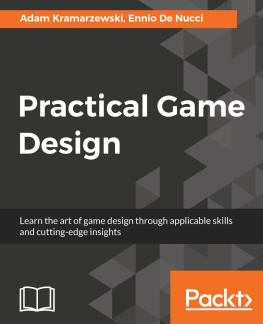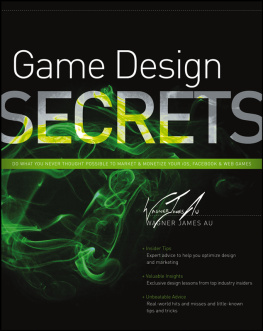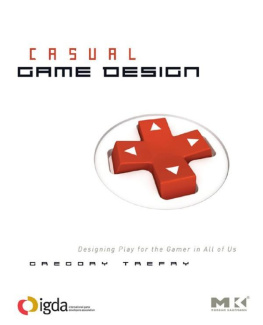A Note on the Text
UNFORTUNATELY, THE ENGLISH LANGUAGE does not provide us with a perfect gender-neutral solution to the pronoun problem. Ive chosen to use he throughout the book to refer to nonspecific people. This is for reasons of readability and conciseness only; unless otherwise specified, masculine pronouns do not refer exclusively to men.
Wed Like to Hear from You
I love talking about game design. If you have comments or questions about the book, please email me at .
You can also address comments and questions concerning this book to the publisher:
OReilly Media, Inc.
1005 Gravenstein Highway North
Sebastopol, CA 95472
(800) 998-9938 (in the United States or Canada)
(707) 829-0515 (international or local)
(707) 829-0104 (fax)
We have a web page for this book, where we list errata, examples, and any additional information. You can access this page at:
http://oreil.ly/designing-games
To comment or ask technical questions about this book, send email to:
For more information about our books, courses, conferences, and news, see our website at http://www.oreilly.com.
Find us on Facebook: http://facebook.com/oreilly
Follow us on Twitter: http://twitter.com/oreillymedia
Watch us on YouTube: http://www.youtube.com/oreillymedia
Safari Books Online
Safari Books Online (www.safaribooksonline.com) is an on-demand digital library that delivers expert content in both book and video form from the worlds leading authors in technology and business.
Technology professionals, software developers, web designers, and business and creative professionals use Safari Books Online as their primary resource for research, problem solving, learning, and certification training.
Safari Books Online offers a range of product mixes and pricing programs for organizations, government agencies, and individuals. Subscribers have access to thousands of books, training videos, and prepublication manuscripts in one fully searchable database from publishers like OReilly Media, Prentice Hall Professional, Addison-Wesley Professional, Microsoft Press, Sams, Que, Peachpit Press, Focal Press, Cisco Press, John Wiley & Sons, Syngress, Morgan Kaufmann, IBM Redbooks, Packt, Adobe Press, FT Press, Apress, Manning, New Riders, McGraw-Hill, Jones & Bartlett, Course Technology, and dozens more. For more information about Safari Books Online, please visit us online.
Part One. Engines of Experience
The Inventor had given them wonderful thingsmachines for grinding corn, for weaving cloth, and countless others. The townspeople loved him.
But he was getting old, and there was only time for only one more invention. So he decided that his last work would be a very special kind of machine. This one would not be for moving or heating or calculating, but for making happiness itself.
The townspeople didnt understand, but they trusted him. Hed never let them down before. So the Inventor retreated into his castle and worked.
Years passed. At first the townspeople waited patiently. Then they doubted. Then they became angry.
Where is it? they asked.
Its taking too long.
Its costing too much.
Hes tricking us.
We must destroy him.
Just as the mob arrived at the castle, the gates opened and the Inventor came out. It is accomplished! he declared. The mob quieted for a moment and he led them inside.
But there was no great engineonly a roomful of tables littered with cards, booklets, and tiny pieces of wood. Where is the machine? asked the leader of the mob, readying his club. Where is the machine of happiness?
It is here, said the Inventor, motioning to the dice, rulebooks, and game boards. Have a seat, and lets play.
Note
GAME DESIGN isnt in code, art, or sound. Its not in sculpting game pieces or painting game boards. Game design means crafting the rules that make those pieces come alive.
BY THEMSELVES, chess pieces are just tiny decorative sculptures. But when we move those pieces around according to a special set of rules, those little statues come alive. They will create a nail-biting finish at a high-stakes tournament. They will generate a world of puzzles in the newspaper. They will spark friendships, tell stories, and teach lessons found nowhere else in the universe.
But not just any set of rules will do. In fact, most sets of rules for pieces on a board wont do any of these wonderful things. Many will collapse into simple, repetitive patterns as players use the same winning strategies over and over. Others are nightmarishly difficult to learn. Still others are so hard to follow that the game becomes a plodding number-crunching exercise.
The unique value of chess is in how it generates a perfect rhythm of puzzle and solution, tension and release. That value isnt in the pieces or the board. Its in the game designthe system of rules that drives the games behavior. A game designers job is to craft systems of rules that create these kinds of results.
Its not easy to know how to achieve game design goals. How would you change chess to make it easier to learn? What would you modify to make it a better spectator sport, or to eliminate the often-repetitive opening moves? Would you add a piece, or remove one? Change how one moves? Reshape the board, add special abilities, change the art, add a story, or make the game play in real time?
The answers to these questions are found in the craft of game design. Game design craft shows how to make games that are hard, easy, or both. It helps us teach players without smothering them. It tells us how to thread stories and rules together into a single system of meaning. The first half of this book is dedicated to this craft.
But even with the best craft in the world, no designer can magically know the answer to every question (though there are those who try). Thats why the second half of this book is about the day-to-day process of design. Real game designers dont just know the answersthey know how to find them using testing, planning, and analysis. Process knowledge shows when to test and how, when to plan and when not to, how to work with others and avoid creative dead ends.
Note
Design craft does not define the purpose of a game. It only shows us how to achieve it.
Some people worry that analyzing game design removes its soulthat understanding the principles of the craft takes away the creativity of the work. But knowing game design craft doesnt mean slavishly following rules to get the same result over and over. It means understanding the trade-offs in every design decision. When games go wrong its rarely because the designer made the wrong choices within their own understanding. Its because they just didnt know the trade-offs they were making. So a designer understanding craft is kind of like an engineer understanding the laws of physics: Newtons laws dont determine whether we build a boat motor or a Saturn V rocket, but they are essential to perfecting either.


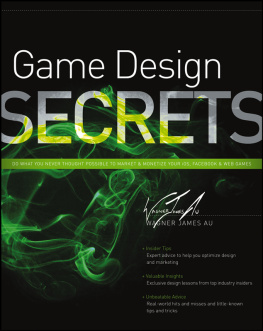
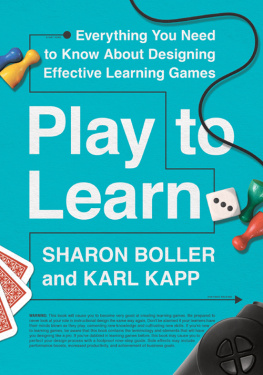
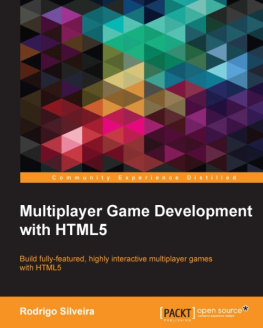
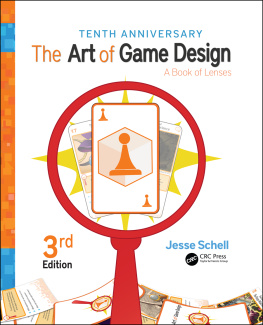
![Scott Rogers [Scott Rogers] - Level Up!: The Guide to Great Video Game Design](/uploads/posts/book/119441/thumbs/scott-rogers-scott-rogers-level-up-the-guide.jpg)
![Tracy Fullerton [Tracy Fullerton] - Game Design Workshop, 3rd Edition](/uploads/posts/book/119440/thumbs/tracy-fullerton-tracy-fullerton-game-design.jpg)
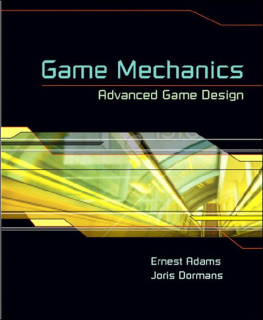
![Ethan Ham [Ethan Ham] - Tabletop Game Design for Video Game Designers](/uploads/posts/book/119417/thumbs/ethan-ham-ethan-ham-tabletop-game-design-for.jpg)
![Chris Bateman [Chris Bateman] - Beyond Game Design: Nine Steps Toward Creating Better Videogames](/uploads/posts/book/119409/thumbs/chris-bateman-chris-bateman-beyond-game-design.jpg)
